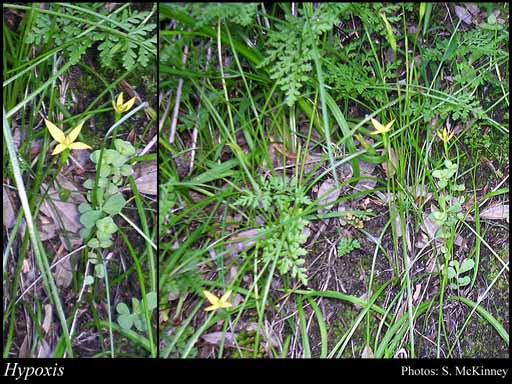- Reference
- Syst.Nat. p986, 1366. (1759)
- Name Status
- Current







Scientific Description
Common name. Stars. Family Hypoxidaceae.
Habit and leaf form. Herbs (small). Perennial. Leaves basal. Cormous, or rhizomatous, or tuberous. Mesophytic. Leaves alternate (clustered); tristichous; sessile; sheathing. Leaf sheaths with free margins. Leaves with ‘normal’ orientation; simple; epulvinate. Leaf blades entire; flat, or solid; terete (more or less); linear, or lanceolate; linear (or narrowly linear); parallel-veined (prominently veined); without cross-venules; sheathing, more or less wholly subterranean, short, cylindrical, forms a tunic which is fibrous or papery, persistent or not persistent. Leaves without stipules. Leaf blade margins entire. Leaves with a persistent basal meristem, and basipetal development. Leaf anatomy. Hairs present. Branched hairs present, or absent. Complex hairs sometimes stellate. Extra-floral nectaries absent. Stem anatomy. Secondary thickening absent.
Reproductive type, pollination. Fertile flowers hermaphrodite. Unisexual flowers absent. Plants hermaphrodite. Floral nectaries absent (nectaries lacking).
Inflorescence and flower features. Flowers solitary, or aggregated in ‘inflorescences’; in racemes, or in panicles. The terminal inflorescence unit racemose. Inflorescences scapiflorous; terminal; flowering stems filiform; scape leafless or with a single sheathing leaf; inforescence corymb-like; with involucral bracts, or without involucral bracts. Flowers pedicellate; ebracteate; bracteolate (solitary or paired); regular; 3 merous; cyclic. Perigone tube present. Free hypanthium very short. Perianth of ‘tepals’; (4–)5–6; 2 -whorled; isomerous; petaloid; similar in the two whorls; white (outside), or yellow (inside), or red (dark red to pale yellow outside); persistent (patent). Androecial members definite in number. Androecium 4–6. Androecial members adnate; united with the gynoecium (more or less attached to the base of the style); all equal; free of one another; 2 -whorled (3+3). Androecium exclusively of fertile stamens. Stamens (4–)5–6; all more or less similar in shape; isomerous with the perianth, or reduced in number relative to the adjacent perianth; at the base of the perianth lobes. Anthers dorsifixed, or basifixed; versatile; dehiscing via longitudinal slits; introrse; tetrasporangiate. Gynoecium 3 carpelled. The pistil (2–)3 celled. Gynoecium syncarpous; synovarious to synstylovarious; inferior. Ovary plurilocular; (2–)3 locular. Gynoecium stylate. Styles 1; free to partially joined; apical. Stigmas (2–)3; (2–)3 - lobed. Placentation axile. Ovules 20–50 per locule (numerous); arillate, or non-arillate; anatropous, or hemianatropous.
Fruit and seed features. Fruit non-fleshy; dehiscent; a capsule. Capsules circumscissile, or transverse rupture near the apex. Seeds copiously endospermic. Endosperm oily. Testa encrusted with phytomelan.
Etymology. From the Greek for "under, somewhat" and "sharp, pointed"; may refer to the capsule, which is elongated and contracted at the base.
Taxonomic Literature
- Lyons, Michael N.; Keighery, Greg J. 2007. A new species of Hypoxis (Hypoxidaceae) from saline wetland margins in Western Australia.
- Wheeler, Judy; Marchant, Neville; Lewington, Margaret; Graham, Lorraine 2002. Flora of the south west, Bunbury, Augusta, Denmark. Volume 1, introduction, keys, ferns to monocotyledons. Australian Biological Resources Study.. Canberra..
- Wheeler, J. R.; Rye, B. L.; Koch, B. L.; Wilson, A. J. G.; Western Australian Herbarium 1992. Flora of the Kimberley region. Western Australian Herbarium.. Como, W.A..